Desandar la Ciudad | Retracing the City | Movimiento Maricas Bolivia
14th August 2023This work was published as a part of Anahí Saravia Herrera’s commission Embodying Resistance/Encuerpando Resistencia: unfinished reflections from the Bolivian territory. It is an existing work created by Movimiento Maricas Bolivia. To see the full commission with further interviews and texts see here.
“The city is a project of modernity thought from the heterosexual-male hegemony where all forms of sexual dissidence are sanctioned and displaced to the underground. “Desandar la ciudad” was a street-political intervention to highlight homophobia in the city of La Paz, a “gay-friendly” city. Through this work, we also discuss the indigenous identities that intersect us as ‘maricones’ (queers/faggots). We recognise ourselves as indian-indigenous-cholas1 from our dissident sexualities, and as we look at ourselves in the mirror, know ourselves to be brown, racialised subjects.” Movimiento Maricas Bolivia
Street intervention / performance, 2017, Historic centre of the city of La Paz
Production: Movimiento Maricas Bolivia
Photography: Huascar I. Pinto Saracho
*The original text is in Spanish and can be seen below. Camilla de la Parra Leyba supported the translation of this work.
14:00. San Francisco. The sun beats down violently on us as we wait for our initiation. People come and go, almost like a silent film in which everyone is moving rapidly without saying anything, without saying anything to each other. The afternoon rushes by the conglomerate of the city that passes before our eyes, speeding up, in turn, to swallow us up in the hustle and bustle that inhabits it. Oblivious to this movement, we observe the bronze river flowing down through the city, dividing it in two: one side for the Indians and another for the Spaniards. We are in the Indian city, our disordered place; the streets and houses organised in a crossflow to the main river, the Choqueyapu, and are lost in the exuberance of their chaos; nothing can contain this liberatory riverbed. The city of the Spaniards, on the other side, is organized in square blocks and perfect streets aligned to a modus vivendi upheld by power. Everything is square in that part of the city, even its main plaza, where the power delusions who have difficulty believing in themselves, converge. The bronze city shines before us to impose itself as the only possibility in our imagination. Fortunately, we can close our eyes and think about this city from our own colours.
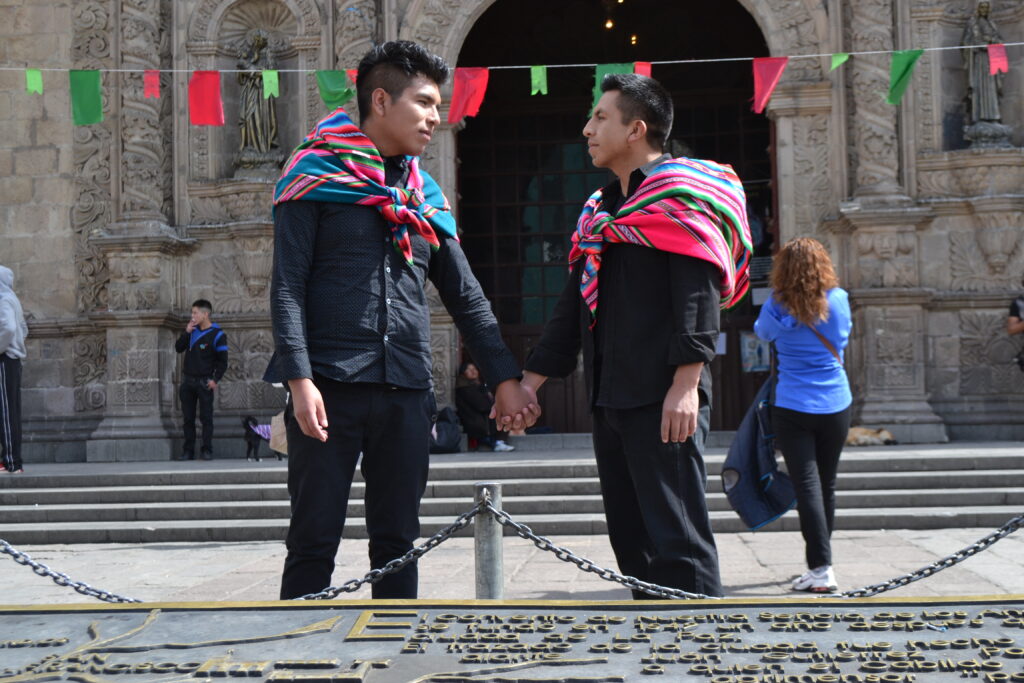
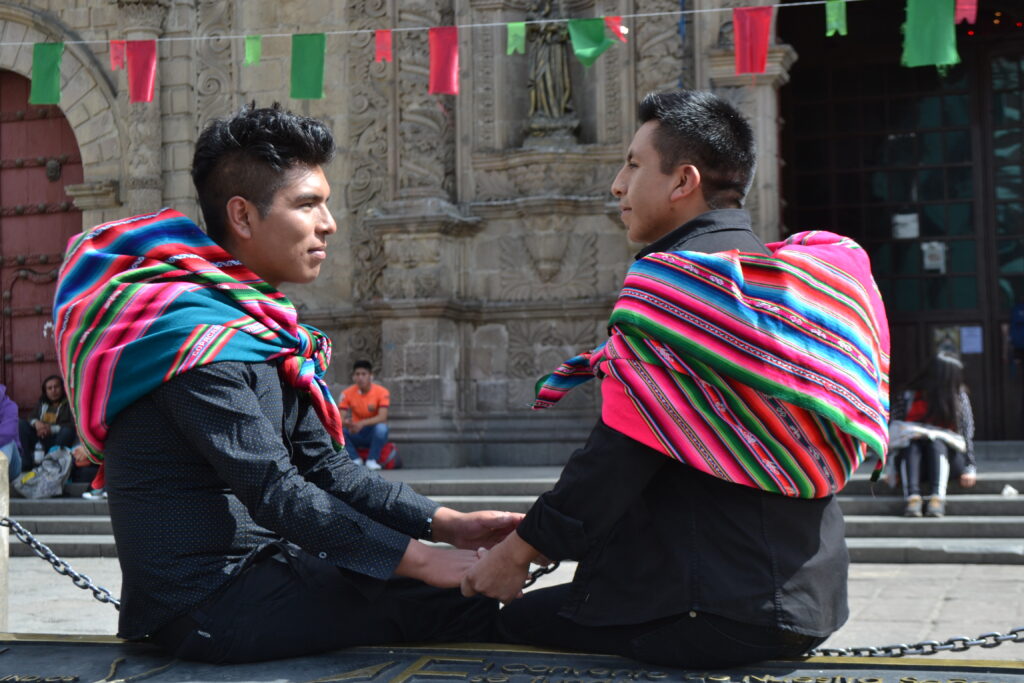
14:35. We begin. A maricueca2 ceremony in which we unfold our colours to carry life, to carry our amariconamientos3 distempering the harmony of the heterosexual, homosexual, social, religious, political institution. To speak by carrying. To carry by speaking. Because it is the memory where we cradled our births and painted with vivid hues that maternal bosom that offered us so much love and warmth. We even carried our dolls emulating our mothers and eluding the patriarchal control expecting us to be “little men” and invading our childhoods with violence. Even then, we laughed, because our aguayos4 back then were white cloths, dirty from being dragged around so much, and used as kitchen rags, which is where we also found our place. From then on, we carried the weight of the mujercito5, the mariconcito6 and the mamito7, accumulating the burden, like our mothers, with every step we took forth and back. It wasn’t easy, for anyone. And it isn’t easy today either.
We spread our affections and look at each other. The Indian city is startled, because at the door of its church, which does not belong to it, two q’iwsas8 kiss each other effusively while everyone pretends not to see anything. Some scroll on their mobile phones to reread their WhatsApp conversations and watch the insolence in the atrium of their church from the corner of their eye. Others put on their headphones to distract themselves and pretend they are not looking, but they are, because curiosity is always more powerful. Some fathers and mothers give us accusing glances, like a silent film, as they divert their path and cover their children’s eyes to avoid the embarrassment of the subsequent explanation. The city doesn’t look at us, but we are there, kissing again to hold hands and inhabit our affections before the impatience of the colonial heteronormativity loses control, because it knows how vulnerable it is before our kisses, flaming an intensifying fire, despite the afternoon continuing to burn within us.
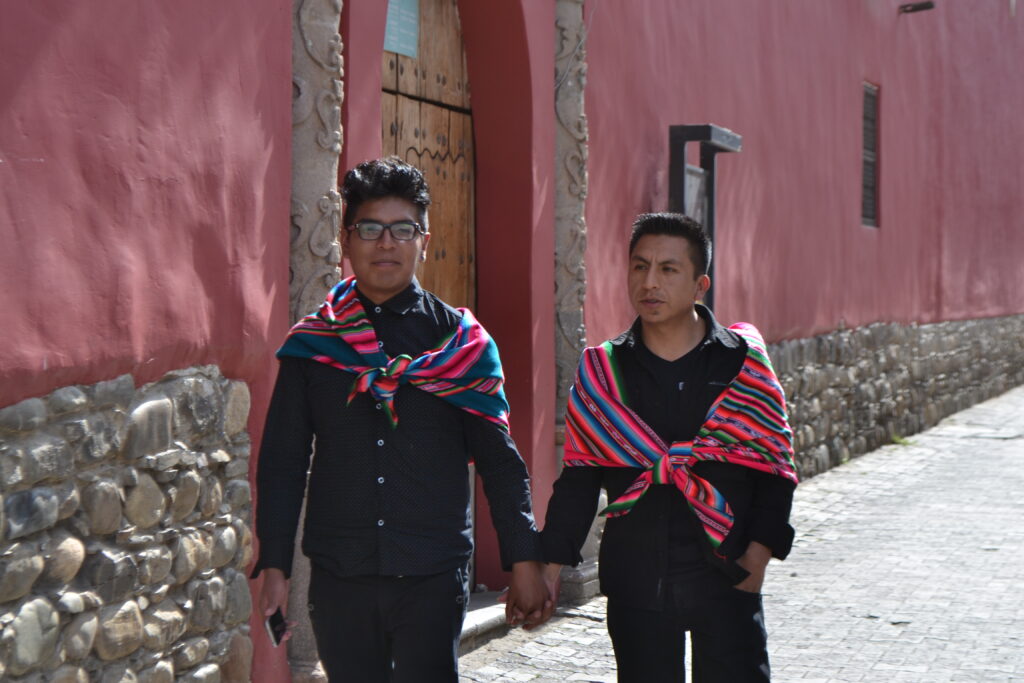
15:00. Pérez Velasco. Crossing the city carrying our queer childhood. The Pérez clock stops at this time to remind us that the city’s queer libido used to overflow here, at a time when homosexual desire inhabited the street furiously, and was not reserved to the virtual apps of today. Have we actually fallen for the capitalist illusion of Grindr9? Should we personify being men, be manly, to triumph in this non-existent virtual space, a hedonistic – phallocentric cult, where to be effeminate, Indian, cholo, fat, AIDS-ridden, old, is to be nobody, because being gay is to be a ridiculous gelebetoso10 poster, where a Nordic Adonis capitalises on faggot desire?
Like a gay nightclub, like Grindr, where they sell us the illusion of freedom while enclosed within four walls that, at a determined time of the night dull us with alcohol, asphyxiate us with love, and drown us in a delirium of the active male, who is not, simply because he does not exist, or should not exist in this binarism of the homosexual entanglements/enmeshments. That is why we enter the street, where we should be, to embark on the journey accompanied by our affections, which need to be aired as much as we do.
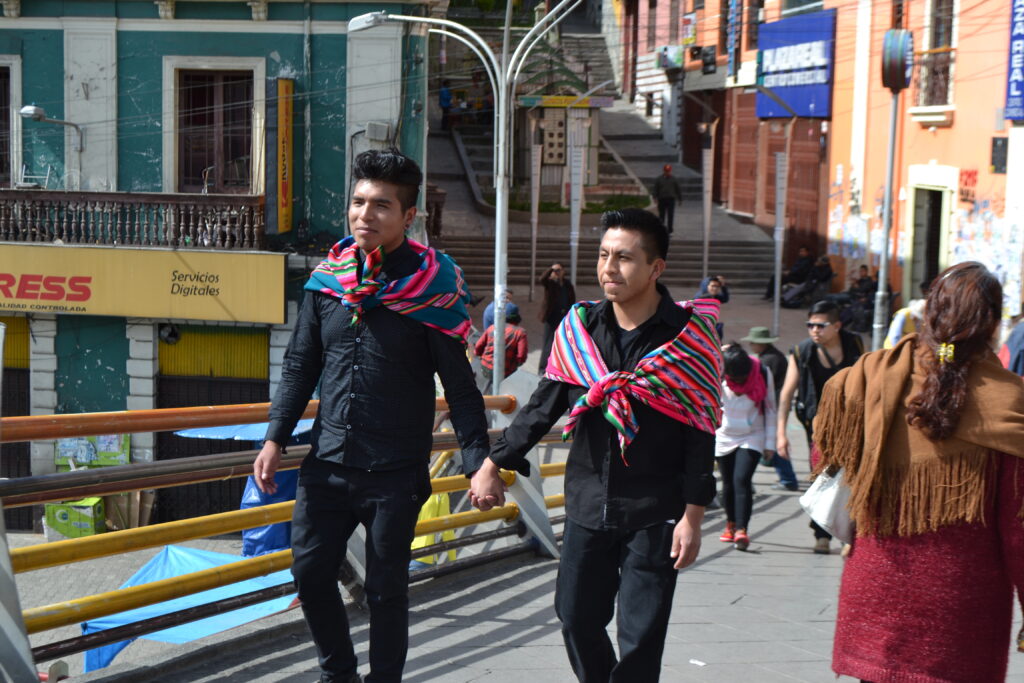
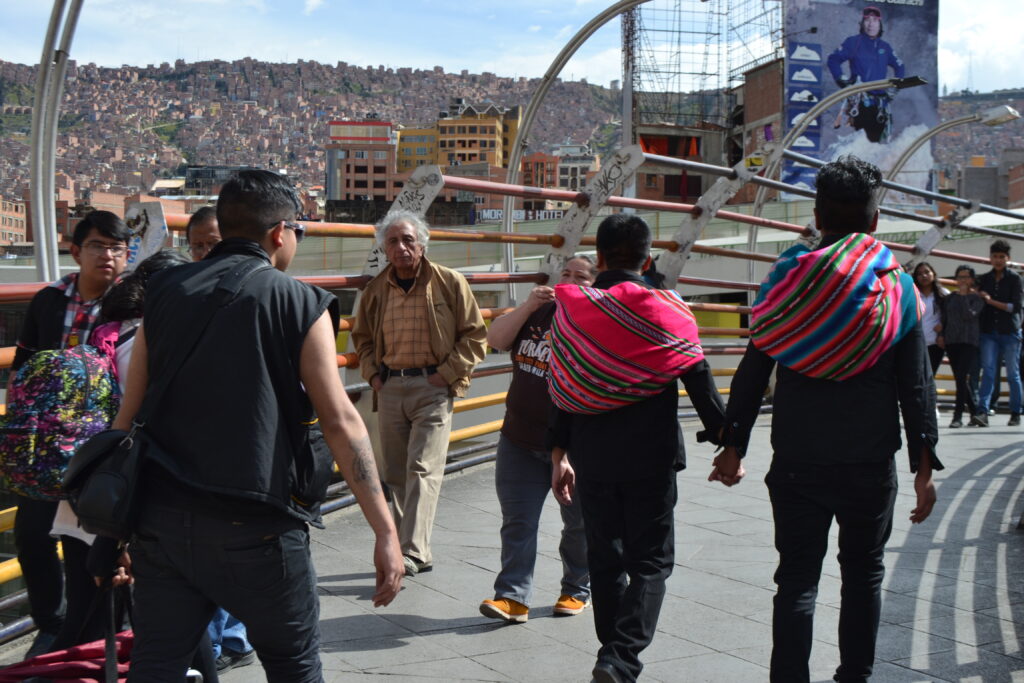
15:40. We flow like a fire that spreads rapidly. Our q’iwsas kisses are the focus of gazes that stop to scrutinise and condemn us to perish in our own fire, the one in which we continue to frolic because we are the nefarious. We wander this city in all its inequalities to think about what it is exactly that we should be proud of and which colours should be ours. But the square part of the city, the city of the Spaniards where there are no Spaniards left, is just waking up from its immemorial slumber, barely noticing our queer walk. Thinking is difficult in this part of the city where a sickly indifference corrodes what little life remains in its streets and scars that, like ghosts, emit inaudible moans as a memory of what it was once. Transiting through Comercio11 warrants raising their gazes to explore the subjectivities that observe us and explore their reasoning, as square as the part of the city they inhabit.
16:15. Plaza Murillo. The nation is literally in her own shit. Above her rises, haughtily, el señorón12 who says he left the torch of freedom burning. Three pigeons take flight, shit on his face, and leave him dumbfounded. The pigeons continue their flight, they are unique, they are the ones who shit on the centre of power. Then they soar, in a flock, to start a choreography to the sound of the chimes that mark the rhythm of the evening. They fly, like people who are detached to what is happening, to what is happening to us, while we unleash to provoke ourselves. We think we are the grandchildren of those Indians who were forbidden to enter the square or of those others who died in the revolts of 1781. But no, we’re just two “maracos kissing in the square”, as a visibly annoyed passer-by just said. Faggots that don’t believe the story of the process of change and even less in that of indigenous representation, an ornament with empty meaning, to which the Indian figures of the millenary peoples have been reduced to and absorbed. Power is like the nothingness that destroys everything. We will not be the faggots that align to power for a crumb of a law that solves nothing, nothing, in practice.
16:50. Masts, behind and in front of us, masts and flags. Of all colours and countries, abandoned to their erection in which they pile up one after the other and side by side. In line, in order, violent and phallic, like the patriotic symbols, those that remain inert while our kisses melt us as uncontrolled, irreverent, and insane subjects in front of this illusion of represented citizenship. The most real thing in this landscape is the questioning gaze of a girl who sharpens her eyes to catch up to us from her uncertainty. The Legislative Assembly is false and illusionary, sleeping the plurinational dream of the just, while the rottenness of the Palacio Quemado13 ferments with increasing intensity next to it. It is mid-afternoon and this putrescence, which eats consciences away, forces us to retreat by taking the shortest route to our own abyss.
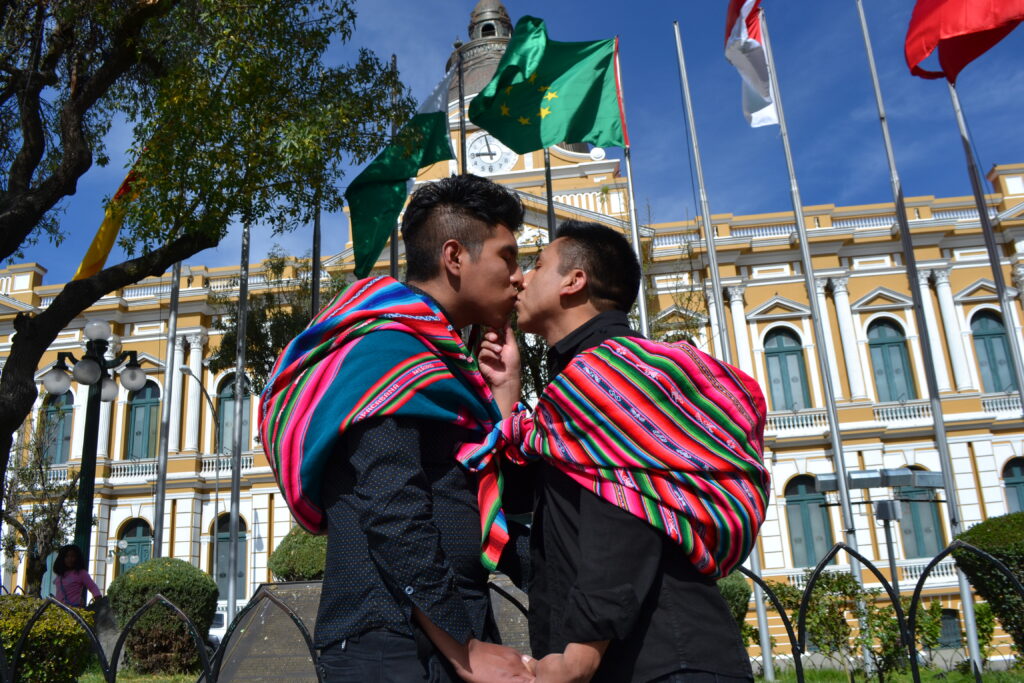
17:25. Camacho Avenue. The street opens up to welcome us while the city expels us. We carry ourselves in this journey through our origins and our colours, our sensibilities and our affections, our dissidences and our affiliations. To transit while carrying. To carry while transiting. The gazes no longer weigh as they did at the beginning for they are just that, gazes that melt into the language of our aguayos or in the fury of our amariconamientos. Behind hides the Illimani14, barely peeping through the cement blocks and blurring itself as it faces the apathy of the metropolis. The city is as cold as the tomb of tyrants, it’s a shadow like the wonder of its absence, as dead as the imaginary of progress it fosters. We burn in that faggot fire that gnaws at us lovingly. There is still some light left for the afternoon. The traffic light, in red, starts its countdown.
Is it really so difficult to carry our self-recognition?
Is it really so hard to be poor, cholo, and a faggot?
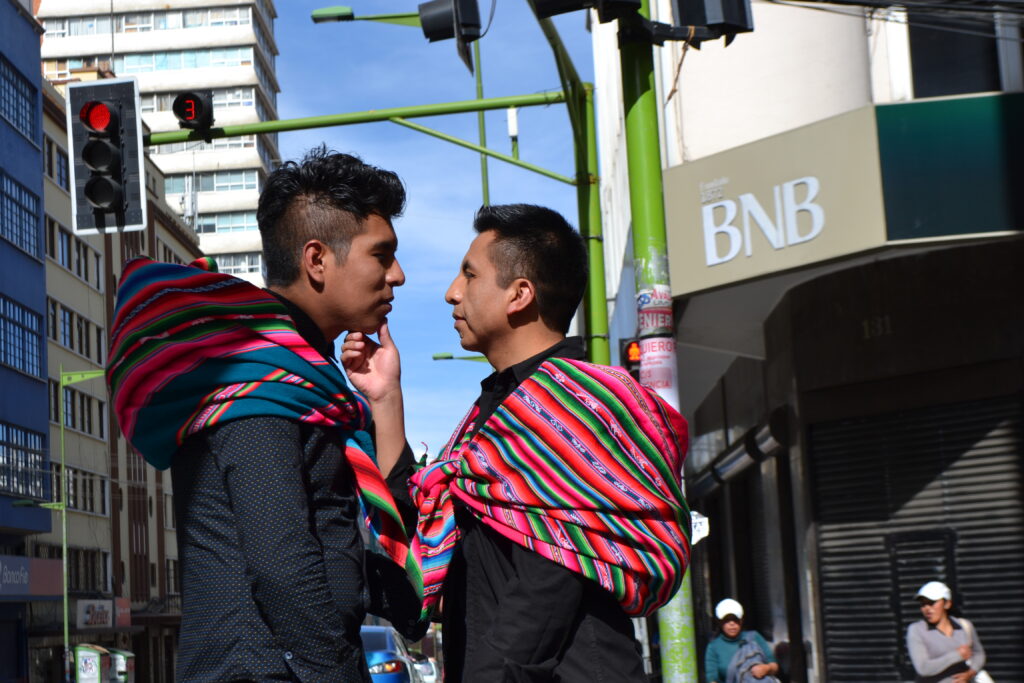
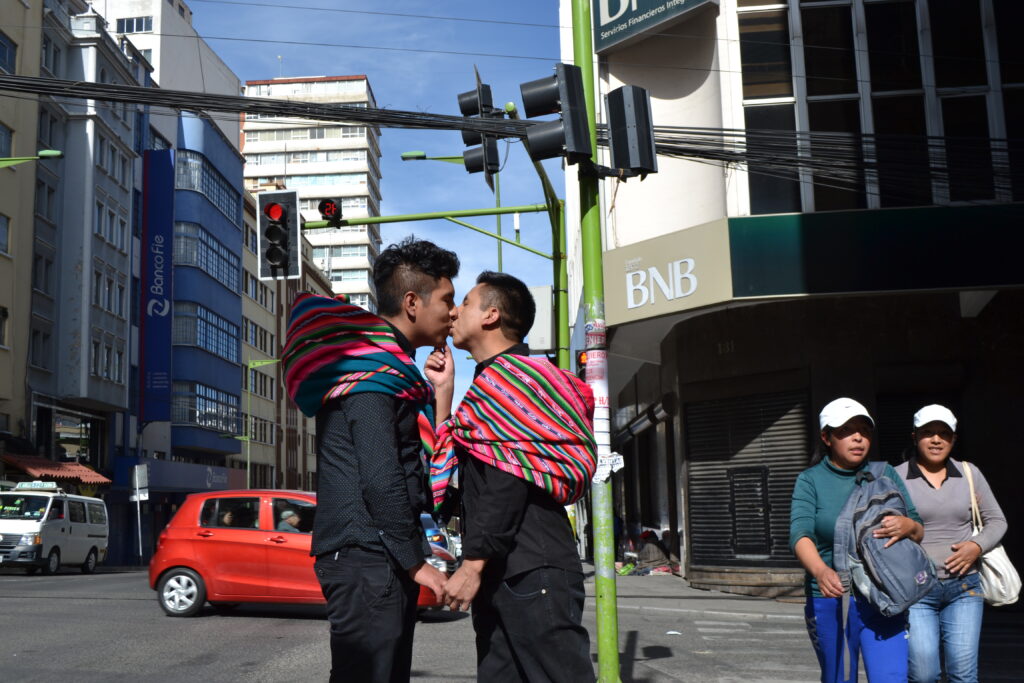
Writen by: Edgar Soliz Guzmán of Movimiento Maricas Bolivia
Desandar la Ciudad
La ciudad es un proyecto de la modernidad pensado desde la hegemonía heterosexual – masculina donde todas las formas de disidencia sexual son sancionadas y desplazadas a la clandestinidad. “Desandar la ciudad” fue una intervención política – callejera para evidenciar la homofobia en la ciudad de La Paz, ciudad gay friendly. Por otro lado, pusimos en discusión las identidades indígenas que nos atraviesan como maricones. Reconocernos indias-indígenas-cholas desde nuestras sexualidades disidentes, mirarnos al espejo y sabernos marrones, sujetos racializados.
14:00 horas. San Francisco. El sol cae violentamente sobre nosotros mientras esperamos iniciarnos. Las personas van y vienen, casi como una película muda en la que todos se mueven aceleradamente sin decir nada, sin decirse nada. La tarde se apresura en el conglomerado de la ciudad que pasa ante nuestros ojos, acelerando, a su vez, para tragarnos en el ajetreo que la habita. Ajenos a ese movimiento, observamos el río de bronce que baja por la ciudad dividiéndola en una parte para los indios y otra para los españoles. Estamos en la ciudad de los indios, nuestro lugar, que no tiene orden; las calles y casas se acomodan como afluencias para el principal río, el Choqueyapu, y se pierden en la exuberancia de su descontrol, nada puede contener este cauce libertario. La ciudad de los españoles, al otro lado, está ordenada en manzanos cuadrados y calles perfectamente alineadas para organizar un modus vivendi sujetado al poder. Todo es cuadrado en esa parte de la ciudad, incluso su plaza principal, donde confluyen esas ilusiones de poder que tanto trabajo les cuesta creerse a ellas mismas. La ciudad de bronce brilla ante nosotros para imponerse como única posibilidad en nuestro imaginario. Por suerte podemos cerrar los ojos y pensar esta ciudad desde nuestros colores.
14:35 horas. Empezamos. Ceremonia maricueca en la que desplegamos nuestros colores para cargar la vida, cargar nuestros amariconamientos destemplando la armonía de la institución heterosexual, homosexual, social, religiosa, política, etc. Hablar cargando. Cargar hablando. Porque es la memoria en la que acunamos nuestros nacimientos y pintamos de matices vivos ese seno materno que tanto amor y calidez nos ofrecía. Incluso nosotros cargamos nuestras muñecas, emulando a nuestras madres y burlando el control machista que nos quería “hombrecitos” y violentaba nuestras infancias; aun así reíamos, porque nuestros aguayos de entonces eran telas blancas, sucias de tanto arrastrarlas, que servían de trapos de cocina donde también encontrábamos nuestro sitio. Desde entonces cargamos el peso del mujercito, del mariconcito y del mamito, acumulando carga, como nuestras madres, en cada paso que avanzábamos y retrocedíamos. No fue fácil, para nadie. Y hoy tampoco lo es.
Desplegamos nuestros afectos y nos miramos. La ciudad de indios se sobrecoge, porque en la puerta de su iglesia, que no le pertenece, dos q’iwsas se besan efusivamente mientras todos disimulan no haber visto nada. Algunos buscan en sus celulares para releer sus conversaciones en WhatsApp y observan de reojo el atrevimiento en el atrio de su iglesia. Otras se colocan los audífonos para distraerse y hacer como que no miran, pero miran, porque la curiosidad puede más, siempre. Algunos padres y madres nos dirigen miradas acusadoras, todo en película muda, mientras desvían su camino y tapan los ojos de sus hijos e hijas para evitar el bochorno de la explicación posterior. La ciudad no nos mira, pero estamos ahí, besándonos otra vez para tomarnos de la mano y habitar nuestros afectos ante la impaciencia de la heteronorma colonial que se descontrola, porque se sabe vulnerable ante nuestros besos que provocan un fuego, más intenso, a pesar de la tarde que sigue ardiendo en nosotros.
15:00 horas. Pérez Velasco. Atravesar la ciudad cargando nuestra infancia maricona. El reloj de la Pérez se detiene a esta hora para recordarnos que aquí se desbordaba la libido marica de la ciudad, en un tiempo en el que el deseo homosexual habitaba la calle, furiosamente, y no se reservaba a las aplicaciones virtuales que hoy existen. ¿Acaso nos hemos creído esa ilusión capitalista de Grindr?, ¿acaso debemos personificar el ser hombres, más hombres, para triunfar en ese inexistente espacio virtual, como culto hedonista – falocéntrico, donde ser afeminado, indio, cholo, gordo, sidoso, viejo, es no ser nadie, porque lo gay es un ridículo poster gelebetoso, donde un adonis nórdico capitaliza el deseo maricueca? Como la disco de ambiente, como Grindr, donde nos venden la ilusión de la libertad encerrados en cuatro paredes que a determinada hora de la noche nos embrutece de alcohol, nos asfixia de amor y nos ahoga en el delirio del macho activo que no lo es, porque, simplemente, no existe o no debiera existir en ese binarismo de los entramados/encamados homosexuales. Por eso entramos a la calle, donde debemos estar, para hacer el recorrido acompañados de nuestros afectos que necesitan airearse al igual que nosotros.
15:40 horas. Fluimos como fuego que se propaga rápidamente. Nuestros besos q’iwsas son el centro de miradas que se detienen a escrutarnos y condenarnos para perecer en nuestro propio fuego, ese en el que seguimos retozando porque somos lo nefando. Desandamos esta ciudad en todas sus desigualdades para pensar de qué, exactamente, debiéramos estar orgullosos y cuáles debieran ser nuestros colores. Pero la parte cuadrada de la ciudad, la ciudad de los españoles donde no quedan españoles, apenas despierta de su modorra de tiempos inmemoriales, apenas se inmuta con nuestro andar marica. Pensar es difícil en esta parte de la ciudad donde una indiferencia malsana corroe lo poco de vida que queda en sus calles y cicatrices que, como fantasmas, emiten quejidos inaudibles como memoria de lo que alguna vez había sido. Transitar la Comercio merece levantar esas miradas para recorrer esas subjetividades que nos miran y explorar sus razonamientos cuadrados como la parte de la ciudad que habitan.
16:15 horas. Plaza Murillo. La patria está cagada, literalmente. Por encima de ella se alza, altanero, el señorón que dice que dejó encendida la tea de la libertad. Tres palomas se asoman al vuelo, le cagan el rostro y lo dejan anonadado. Las palomas continúan su vuelo, son únicas, son las que se cagan en el centro del poder. Luego se elevan, en bandada, para iniciar una coreografía al son de las campanadas que marcan el ritmo de la tarde. Vuelan, como las personas ajenas a lo que sucede, a lo que nos sucede, mientras nos desatamos para provocarnos a nosotros mismos. Creemos ser los nietos de esos indios que tenían prohibido el ingreso a la plaza o de esos otros que murieron en las revueltas de 1781. Pero no, solo somos dos “maracos besándose en la plaza”, como lo acaba de decir un transeúnte visiblemente molesto. Maracos que no creemos el cuento del proceso de cambio y menos el de la representación indígena, como ornamento vacío de sentido, a la que han reducido o absorbido a las figuras indias de los pueblos milenarios. El poder es como la nada que lo destruye todo. No seremos los maracos alineados al poder por un mendrugo de ley que en la práctica cotidiana no resuelve nada, nada.
16:50 horas. Mástiles, detrás y delante de nosotros, mástiles y banderas. De todos los colores y países, abandonados a su erección en la que se acumulan uno detrás de otro y uno al lado de otro. En fila, en orden, violentos y fálicos, como los símbolos patrios, esos que permanecen inertes mientras nuestros besos nos derriten como sujetos descontrolados, irreverentes e insanos delante de esa ilusión de representación ciudadana. Lo más real de este paisaje, la mirada interrogante de una niña que aguza la vista para alcanzarnos desde la incertidumbre. Lo más falso e ilusorio, una Asamblea Legislativa que duerme el sueño plurinacional de los justos, mientras al lado se fermenta, cada vez con mayor intensidad, la podredumbre del Palacio Quemado. Es media tarde y esta pudrición, que carcome conciencias, nos obliga a retirarnos tomando el camino más corto hacia nuestro propio abismo.
17:25 horas. Avenida Camacho. La calle se abre para recibirnos mientras la ciudad nos expulsa. Cargamos con nosotros mismos en este transitar por nuestros orígenes y nuestros colores, nuestras sensibilidades y nuestros afectos, nuestras disidencias y nuestras filiaciones. Transitar cargando. Cargar transitando. Las miradas ya no pesan como al principio, son solo eso, miradas que se deshacen en el lenguaje de nuestros aguayos o en la furia de nuestros amariconamientos. Atrás el Illimani se oculta, apenas se asoma a través de los bloques de cemento y se borronea a sí mismo ante tanta desidia de la metrópoli. La ciudad es fría como la tumba de tiranos, es sombra como la maravilla de su ausencia, es muerte como el imaginario de progreso que fomenta. Ardemos en ese fuego amariconado que nos carcome amorosamente. Todavía queda algo de luz para la tarde. El semáforo, en rojo, inicia su cuenta regresiva.
¿Acaso es difícil cargar el reconocimiento de nosotros mismos?
¿Tan difícil ser pobre, cholo y maricón?
Movimiento Maricas Bolivia is a community-based LGBTIQ+ organisation made up of people who self-identify as indian-indigenous-cholas as well as maricas-machorras-travas-cuir15. It was founded in May 17, 2010 with the broadcasting of its first radio program called Soy Marica y Qué (2010 – 2010), broadcast through Radio Deseo in the city of La Paz. Subsequently, the program moved to the city of El Alto under the name Nación Marica (2016). In 2022, Movimiento Maricas Bolivia produced the audiovisual program and street interventions Nación Marica Callejera that has more than thirty-three programs recorded in public spaces across La Paz and El Alto, featuring thirty-three guests who reflect on social, political, sexual, and indigenous issues in the country. This program is broadcast through their Youtube Channel and is the only audiovisual program whose signature discursive approach and embodied identities are indigenous-chola, as well as marica-machorra-trava-cuir. Nación Marica has received the “Periodismo en Derechos Humanos” award (2016 and 2017) from Católicas por el Derecho a Decidir for the radio reports Nuestra venganza es ser felices: historias de amor y resistencia política homosexual (Joy is our revenge: love stories and queer political resistance) and Morir por ser mujer trans en Bolivia: Dayana Kenia, una historia tan lejos de la justicia (Dying for being a trans woman in Bolivia: Dayana Kenia a story far away from justice. They have also received the “Periodista Sin Riesgo” award (2018) from Católicas por el Derecho a Decidir and Alianza por la Solidaridad for the radio report ¿Abortan todas, abortan las lesbianas? Situación del aborto en Bolivia desde una mirada lésbica. (Do all women abort? Do lesbians abort? Abortion in Bolivia from a lesbian perspective.) IG:maricas_bolivia, maricasbolivia.wordpress.com
Movimiento Maricas Bolivia es una organización de base comunitaria LGBTIQ+ conformada por personas que se autoidentifican como indias-indígenas-cholas además de maricas-machorras-travas-cuir. Fue fundada el 17 de mayo del año 2010 con la emisión de su primer programa radial denominado “Soy Marica y Qué” (2010 – 2015), emitido a través de Radio Deseo 103.3 F.M. de la ciudad de La Paz. Posteriormente, el programa se traslada a la ciudad de El Alto con el nombre de “Nación Marica” (2016), emitido en Radio FEJUVE 875 F.M. Asimismo, “Nación Marica” (2017 – 2020), se emite por Radio Líder 97.0 F.M., también en la ciudad de El Alto. Desde el año 2022 Movimiento Maricas Bolivia produce el programa audiovisual (intervenciones callejeras) “Nación Marica Callejera” que cuenta con más de 33 programas grabados en espacios públicos de La Paz y El Alto y 33 invitadas que reflexionan sobre problemáticas sociales, políticas, sexuales e indígenas del país. Este programa se emite a través del canal de YouTube Movimiento Maricas Bolivia y es el único programa audiovisual cuya impronta discursiva, corporal e identitaria, es india-indígena- chola además de marica-machorra-trava-cuir. “Nación Marica” ha recibido el premio “Periodismo en Derechos Humanos” (2016 y 2017) de Católicas por el Derecho Decidir por los reportajes radiales Nuestra venganza es ser felices: historias de amor y resistencia política homosexual y Morir por ser mujer trans en Bolivia: Dayana Kenia, una historia tan lejos de la justicia. También la recibido el premio “Periodista Sin Riesgo” (2018) de Católicas por el Derecho a Decidir y Alianza por la Solidaridad por el reportaje radial ¿Abortan todas, abortan las lesbianas? Situación del aborto en Bolivia desde una mirada lésbica. IG:maricas_bolivia, maricasbolivia.wordpress.com
Footnotes:
1 Editor’s Note: Chola, is a term used for an indigenous woman in Bolivia (and neighboring Andean regions), one who usually wears traditional clothes. It is a term that can be used in a derogatory manner, with racist tones but in this context is being reappropriatedted.
2 Editor’s Note: Maricueca: Slang for effeminate man, another term for faggot, derogatory.
3Editor’s Note: Faggotry
4 Awuayos, or aguayos are rectangular pieces of coloured wool that Bolivian indigenous women use as a complement to their clothing and, primarily to carry their children or to carry items. Their use has spread to Peru, Argentina, Ecuador and Chile through immigration. Generally awuayos are very colourful, with alternating coloured stripes and simple designs. In Quechua they are called ‘llijlla’.
5 Editor’s Note: Mujercito, grammatically masculine word for woman. Also a diminutive, which conveys certain tenderness, but tends to be used derogatorily.
6 Editor’s Note: Mariconcito, diminutive for faggot (usually derogatory).
7 Editor’s Note,Mamito: grammatically masculine word for mother. Also a diminutive.
8 Q’iwsas: Word in the Aymara language for homosexual. According to the Vocabulario de la lengua aymara (1612) by Jesuit Father Ludovico Bertonio, q’iwsa refers to the “nefarious sin”. The entry in the Bilingual Spanish-Aymara Dictionary (2002) by Felix Laime Pairumani is “effeminate, faggot, neither man nor woman”.
9 Grindr is a geo-social application aimed at the gay public that allows users who have it installed to locate and communicate with other gay and bisexual men in the vicinity.
10 Editor’s Note: Term comes from the acronym GLBT (gay, lesbian, bisexual, transexual) with the suffix ‘oso’ which indicates suffering from an illness.
11 Pedestrian street in the historic centre of the city of La Paz, a route leading to the main square and the scene of many revolutionary struggles. It is part of the gay cruising circuit in the city of La Paz.
12 Statue of Pedro Domingo Murillo in the main square of the city of La Paz. In 1809, he led a group of rebels who conspired and revolted on 16 July 1809. A few days later, they attended a town meeting to announce a document called Proclama de la Junta Tuitiva, which expressed the liberation of the lands of Upper Peru from the Spanish Empire.
13 The Palacio de Gobierno, popularly known as the Palacio Quemado (Burnt Palace) after a fire in 1875, is the Presidential Palace of Bolivia, the main seat of the Bolivian Executive Branch and the office and seat of functions of the President of Bolivia. The building is located on Calle Comercio in front of Plaza Murillo in the city of La Paz, next to the Metropolitan Cathedral, and diagonally to the left of the Legislative Palace, where the Bolivian Parliament convenes.
14 Illimani, at 6462 meters above sea level, is a mountain in Bolivia, located near the city of La Paz. It is the highest altitude of the Cordillera Real and the second highest in Bolivia (behind Sajama, which belongs to the Cordillera Occidental). It is located in the province of Pedro Domingo Murillo. Symbolically, it is the mountain, apu, tutelary of the city of La Paz.
15 Editor’s Note: Roughly translates to faggots-dykes-trans-queers, it is important to keep these in Spanish throughout because, in part, the work of Movimiento Maricas Bolivia looks to explode and explore the locality of each of these experiences, which are untranslatable and are defined by class as well as through their positionality in the global south.